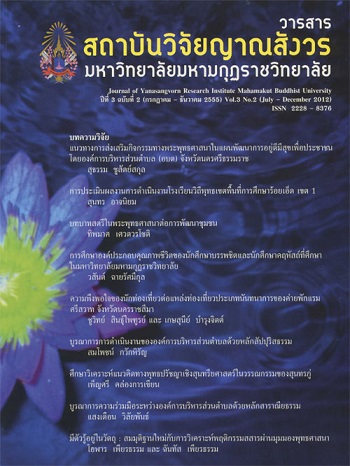The role of women in Buddhism in the community
Main Article Content
Abstract
This research focuses on studying the women’s roles in Buddhism and Community Development. Here, we bring together studies that examine the quality and obstacle of community development of the women in Buddhism. The populations of this study are eighty students and staffs in Mahapajapati Buddhist College and Mahamakut Buddhist University in 2011. The instrument of this study is the questionnaire about the women’s roles in Buddhism and Community Development for studying the quality and obstacle of community development of the women in Buddhism. Findings The women in Buddhism have the high level of the roles in Buddhism and Community Development. There are three sections that the women in Buddhism take part in highest. The first section is occupational training for women that has the high average. The second is academic service for community and the third is moral development for youth. The women’s roles in Buddhism and Community Development of the section of moral development for youth have the high level when we consider each side: goal ranking of moral development plan and project is the highest, the second is community coordination of moral development, and teaching moral for youth to protect themselves is the lowest. The women’s roles in Buddhism and Community Development in the section of occupational training for women have the highest level when we consider each side: survey of the community need in occupational training for women and community coordination in occupational training for women have the highest average while the evaluation of occupational training for women is the second and the lowest is the follow- up of occupational training for women. The women’s roles in Buddhism and Community Development of the section of academic service for community are very high in average when we consider each side: the highest is community coordination in academic service. The second is the evaluation of occupational training for women. The lowest average is the follow - up of occupational training for women. The women’s roles in Buddhism and Community Development in the section of sex have the highest level when we consider each side: the moral development for youth is the highest. The second is the academic service for community and the lowest is the occupational training for women. In the female section found that the moral development for youth is the highest. The second is the academic service for community and the lowest is the occupational training for women. The women’s roles in Buddhism and Community Development are high level in both three sections of the age under 30 years old, the age between 30-45 years old and the age over 46 years old when we consider each side: the age under 30 years old found that the academic service for community is the highest then the moral development for youth is the second and the lowest is the occupational training for women. The age between 30-45 years old found that the moral development for youth and the occupational training for women are the highest and the lowest is the academic service for community. The age over 46 years old found that the occupational training for women is the highest then the academic service for community is the second and the lowest is the moral development for youth. The women’s roles in Buddhism and Community Development are high level in the moral development for youth from the findings of the students when we consider each side: the findings of the first year student found that the moral development for youth is the highest then the second is the occupational training for women and the lowest is the academic service for community. The findings of the second year student found that the academic service for community is the highest then the moral development for youth is the second and the occupational training for women is the lowest. The findings of the third year student found that the moral development for youth is the highest then the second is the occupational training for women and the academic service for community is the lowest. The women’s roles in Buddhism and Community Development that are considered by the positions of the university personnel; instructors and office workers, are high in both three sections when we consider each side: The findings of the instructors found that the moral development for youth is the highest then the second is the academic service for community and the lowest is the occupational training for women. The findings of the office workers found that the occupational training for women is the first high level, the second is the academic service for community and the last is the moral development for youth. The suggestions and the solutions for the problem of the women’s roles in Buddhism and Community Development from this paper found that the budget of the operation for the women in Buddhism and Community Development is very little when we consider in percentage. The budget is the highest percentage of problem then the second problem is a little time in planning and running the project, the lowest percentage of problem is a few leaders of project running. The need of the promotion for the women’s roles in Buddhism and Community Development is the highest percentage when we consider of the budget. Secondly, we need the labor market to support after the occupational training.
Article Details
References
แผนพัฒนาเศรษฐกิจและสังคมแห่งชาติฉบับที่ 10 (2550-2554) หน้า 8นโยบายและยุทธศาสตร์การวิจัยของชาติ (พ.ศ. 2551-2553 )
กิ่งแก้ว อินหว่าง และวีรศักดิ์ อนันตมงคล ,การดำเนินงานกลุ่มออมทรัพย์เพื่อการผลิตกับการพัฒนาชนบท,กรุงเทพฯ : กรมการพัฒนาชุมชน, 2532.
สมหวัง พิธิยานุวัฒน์. 2545. “บทปริทัศน์บทความเรื่องวิธีวิทยาการวิจัย: เครื่องมือหรือวิธีคิด”. วารสารวิธีวิทยาการวิจัย ปีที่ 15 ฉบับที่ 3 (กันยายน-ธันวาคม 2545).
เฉลียว บุรีภักดี และคณะ(2545).ชุดวิชา การวิจัยชุมชน.กรุงเทพฯ : เอส.อาร์. พริ้นติ้ง แมสโปรดักส์.
ประเวศ วะสี(2541).ยุทธศาสตร์ชาติเพื่อเข้มแข็งทางเศรษฐกิจสังคมและศีลธรรม กรุงเทพฯ:หมอชาวบ้าน


